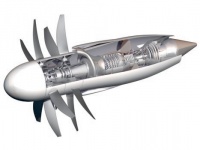Rolls-Royce technology chief Ric Parker

In the emotive language of some climate campaigners, the jet engine is often portrayed as the ultimate villain: a fuel-guzzling relic of the 20th century, incapable of meeting our low-carbon modern-day demands.
However, an hour in the company of Prof Ric Parker, head of research and technology at Rolls-Royce, quickly and convincingly refutes any notion that the technology has reached its use-by date.
Parker, who wields an annual research budget of around £850m and directs a global research base consisting of 29 university technology centres (UTCs), is under no illusions about the scale of the challenge he faces.

In recent years, the drive for more efficient and quieter turbofans — the engines that power most civil airliners — has seen the introduction of ever-larger fans in an effort to route a larger mass of air around the turbine than passes though it. These engines are said to have a higher bypass ratio.
However, there are limitations to the gains possible with existing designs. ’As you come up and up in fan diameter, you get to a point where the weight of the fan and the drag from the casings start to eat into that efficiency,’ explained Parker. ’The idea was to go back to propellers, get rid of the fan case, get rid of all this extra weight around it and then you can make your blades 4m in diameter.’
Although the open-rotor concept bears a passing resemblance to the traditional propeller, there are, he added, considerable differences. ’Conventional props limit the speed of the aircraft. The big difference between the open rotor and the prop is that there will be two rotors spinning in opposite directions. In a conventional prop, the air itself comes out spinning so only part of the momentum is pushing the aircraft forward; the rest is trying to turn itself around and is wasted. If you put a second rotor spinning in the opposite direction, you can speed up the air, but you also take out the spin, so you finish up with a high-speed propeller that can propel the aircraft at the sort of velocities and altitudes they fly at today but with probably a 15 per cent better fuel efficiency than an enclosed fan,’ explained Parker.
Last month, Rolls-Royce announced that it is to work with Boeing, RUAG aerospace and German engineering company Deharde Maschinenbau on the development of a concept open-rotor-powered aircraft that could be tested as soon as next year.
Parker is excited about the potential of the technology. ’That’s [the open-rotor engine] the only step-change technology we can see today in this 10-year window,’ he said. ’If we focus as a world on saying CO2 is the biggest problem, that’s the right answer. The downside is it will be noisier than an enclosed turbofan.’
Despite its promise, however, its fate will largely be shaped by political decisions and Parker stressed that it is simply one of a number of options. ’We are working at the same time on the most advanced enclosed turbofans that we can see for that same time period because we just don’t know. It’s going to be part, ultimately, of a public debate — somebody’s got to say we’re prepared to have a quiet aircraft, but not the quietest aircraft, for the sake of keeping CO2 down,’ he said.
One area that Parker does not anticipate making a huge impact on in the timeframe is biofuels. ’Within that 2020 horizon, we don’t see alternative fuels playing a major role,’ he said. ’We’re not going to all be flying on hydrogen or biofuels in that time, so really it’s got to come from increasing the engine efficiency and that’s where we plough our research.’ One of the trickiest areas of this research is noise reduction.
’Noise is a complicated issue’, said Parker. ’We’ve been tracking down towards the target but you can start to see it getting harder and harder. If you want a quiet engine, put a big fan on the front and, up to a certain point, that makes fuel efficiency good as well, but if you carry on increasing the fan size, slowing down the jet stream behind the fan, noise gets better and better, but you come to a point where weight and drag of the fan start to eat into fuel consumption.’
Noise reduction is, therefore, often about making subtle tweaks to the engine design. He said that some particularly useful lessons were learned from the recent €112m (£99m) European SILENCER programme. ’The shape of the fan, how you position the outlet guide vane behind the fan, where you put it relative to the fan and what shape it is relative to the back of the fan all affect the noise you hear from the fan,’ explained Parker.
Register now to continue reading
Thanks for visiting The Engineer. You’ve now reached your monthly limit of premium content. Register for free to unlock unlimited access to all of our premium content, as well as the latest technology news, industry opinion and special reports.
Benefits of registering
-
In-depth insights and coverage of key emerging trends
-
Unrestricted access to special reports throughout the year
-
Daily technology news delivered straight to your inbox










UK Enters ‘Golden Age of Nuclear’
Anybody know why it takes from 2025 to mid 2030's to build a factory-made SMR, by RR? Ten years... has there been no demonstrator either? Do RR...